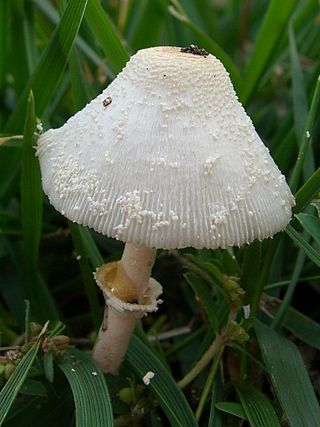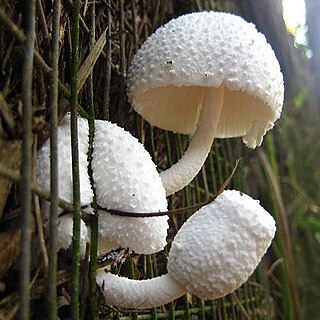
Leucocoprinus cepistipes, is a species of fungus in the family Agaricaceae. It is typically found on wood debris, such as wood chips but may also grow in potted plants or greenhouses. Typical characteristics include a fine-scaled bell-shaped cap, a partial veil, and a tendency to bruise a yellow to brown when handled.

Leucocoprinus cretaceus is a species of mushroom producing fungus in the family Agaricaceae. It is likely tropical in origin although it was first documented in Europe where it was often found growing in greenhouses and bark beds. However many early observations conflate this species with Leucocoprinus birnbaumii or Leucocoprinus cepistipes despite sharing only some superficial similarities. This fungus is quite versatile even for a saprotroph and is often found growing in clusters on woodchips, sawdust and compost heaps as well as directly from the ground or on trees. It may also appear in plant pots and greenhouses in colder countries in which it is not well equipped to survive outside.
Leucocoprinus flavescens is a species of mushroom-producing fungus in the family Agaricaceae.
Leucocoprinus acutoumbonatus is a species of mushroom producing fungus in the family Agaricaceae.
Leucocoprinus delicatulus is a species of mushroom producing fungus in the family Agaricaceae.
Leucocoprinus pusillus is a species of mushroom producing fungus in the family Agaricaceae.
Leucocoprinus muticolor is a species of mushroom producing fungus in the family Agaricaceae.
Leucocoprinus discoideus is a species of mushroom producing fungus in the family Agaricaceae. In the local language when the mushroom cap is open it is known as batakania or bepokua pembe when it is immature with a closed cap. However 'bepokua' may also be used to refer to other similar looking mushroom species such as Micropsalliota bambusicola.
Leucocoprinus elaeidis is a species of mushroom-producing producing fungus in the family Agaricaceae. In the local language, it is commonly known as elela.
Leucocoprinus citrinellus is a species of mushroom producing fungus in the family Agaricaceae.
Leucocoprinus austrofragilis is a species of mushroom producing fungus in the family Agaricaceae.
Leucocoprinus violaceus is a species of mushroom producing fungus in the family Agaricaceae.
Leucocoprinus venezuelanus is a species of mushroom producing fungus in the family Agaricaceae.
Leucocoprinus magnusianus is a species of mushroom producing fungus in the family Agaricaceae.
Leucocoprinus nanianae is a species of mushroom producing fungus in the family Agaricaceae.
Leucocoprinus truncatus is a species of mushroom-producing fungus in the family Agaricaceae.
Leucocoprinus parvipileus is a species of mushroom producing fungus in the family Agaricaceae.
Leucocoprinus tephrolepis is a species of mushroom producing fungus in the family Agaricaceae.
Leucocoprinus gandour is a species of mushroom-producing fungus in the family Agaricaceae.

Leucoagaricus croceovelutinus is a species of mushroom-producing fungus in the family Agaricaceae.


